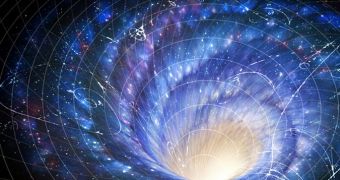According to the conclusions of a new study, it would appear that the gigantic mass our galaxy has may contribute to underlying the asymmetry in decay rates between matter and antimatter. This phenomenon, called charge-parity (C-P) violation, has remained mysterious for years.
The Milky Way has a tremendously large mass, accounted for by both normal, baryonic matter and dark matter. The latter makes its existence known only by the gravitational interactions it has with normal matter.
This mass is spinning, and is therefore controlled by the rules explaining the physics of angular momentum. When placing such a heavy, spinning object inside spacetime, the end result is the emergence of distortions in the latter.
Astrophysicists know about two types of distortions – frame-dragging and time dilation. The former is a process in which spacetime is wrapped around a massive spinning body, as proposed in Albert Einstein's Theory of General Relativity.
Time dilation is a distortion that affects only time, stretching it to some extent. Experts have been analyzing these two phenomena around Earth, which is also capable of producing them. But the Milky Way does it at a much larger scale.
Using these data, astronomers can now attempt to explain why baryonic matter and antimatter exist in the Universe in the proportions they do today. Most of the Cosmos is made up of normal matter, even though equal amounts of the two stuff were produced during the Big Bang.
The event, which took place some 13.75 billion years ago, should have created matter and antimatter in equal, complementary proportions. According to the best theory we have on explaining the Universe, none of the things we see around us in space should exist.
Astronomers widely agree that something happened during the early days of the Cosmos, an event that allowed matter to emerge victorious in its battle against antimatter. Otherwise, the two should have annihilated each other, leaving the Universe devoid of anything.
Mark Hadley, a physicist at University of Warwick in the United Kingdom, says that frame-dragging and time dilation could account for why matter and antimatter decay at different rates. It could be that the particles simply react differently to the two phenomena.
“These [asymmetries] have been measured but never explained. This research suggests that the experimental results in our laboratories are a consequence of galactic rotation twisting our local space-time,” the expert explains in a statement.
“If that is shown to be correct then nature would be fundamentally symmetric after all. CP violation is seen as the key to explaining the matter asymmetry in the Universe, but the measured CP violation is inadequate to explain the Universe that we see today,” he adds.
Rather than using the CP violations, the expert proposes using the spinning of massive structures that formed in the early Universe as a starting point. These objects include the first galaxies, which observations showed were developing just a couple hundred million years after the Big Bang.
“This radical prediction is testable with the data that has already been collected at CERN and BaBar by looking for results that are skewed in the direction that the galaxy rotates,” Hadley writes in this month's issue of the scientific journal Europhysics Letters.
The BaBar experiment is installed at the Stanford University's SLAC National Accelerator Laboratory. Together with the Large Hadron Collider (LHC), operated by CERN underneath Geneva, the instrument is studying CP violations in elementary particles.
This work may ultimately shed more light on which of the phenomena may be responsible for the matter/antimatter asymmetries, Space reports. As the world's largest, most energetic particle accelerator, the LHC is uniquely equipped to conduct such investigations.

 14 DAY TRIAL //
14 DAY TRIAL //